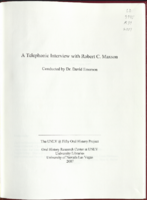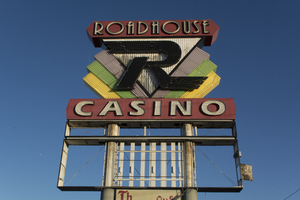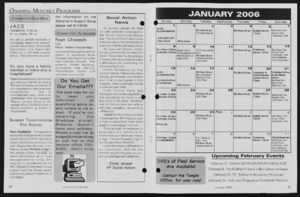Search the Special Collections and Archives Portal
Search Results

Transcript of interview with William Morgan by David G. Schwartz, October 21, 2016
Date
2016-10-21
Archival Collection
Description
William Morgan was born in Kansas City, Missouri and moved to Las Vegas with his family in 1969. Morgan entered the slot industry early by becoming an instructor at his father’s gaming school which provided instruction on slot and arcade repair and maintenance. His start in the gaming industry was in 1989 when he became a slot technician at the Imperial Palace. Morgan would later move to the MGM Grand as a journeyman slot technician in 1993 and eventually to the Stratosphere in 1996 as shift lead slot technician. Shortly thereafter, Morgan moved to Tunica, Mississippi to become director of slot technical and arcade at Grand Casino Tunica. After moving back to Las Vegas, Morgan became a lead slot technician at New York-New York as it was opening as well. After going back to Grand Casino Tunica for a short period of time, Morgan returned to MGM Grand and eventually back to New York-New York where he was able to promote to slot technical manager. He then moved to the Aladdin to also become slot technical manager where he stayed until 2004. He held the same position at the Lady Luck and later helped to develop The Plaza in Downtown Las Vegas. In 2005, Morgan began working for AC Coin & Slot as western regional service manager and was later promoted to national service manager in 2011. He worked at AC Coin & Slot until it closed in 2013. The interview with Morgan starts with his discussion of his background in slot repair and management, including his experiences in opening several properties. He goes on to give his opinions on which qualities make good slot managers and then discusses his approaches to both laying out a slot floor and interacting with customers. Morgan then describes how slot machines have changed since he started in the industry. The future of slot machines is also mentioned, particularly how the use of Wi-Fi technology could change the way games are played. The interview finalizes with Morgan’s advice to those who wish to go into the slot industry.
Text

Transcript of interview with Robert C. Maxson by Dr. David Emerson, May 15, 2007
Date
2007-05-15
Archival Collection
Description
Dr. Robert C. Maxson was president of UNLV for ten years, 1984 to 1994. When he arrived, discussions were already under way about developing an engineering school. Certain elements in the community, such as Summa Corporation, were lobbying for such a program here in southern Nevada. Dr. Maxson began receiving printed materials and phone calls about it, and he started putting his fund raising skills to good use. He believes that civic pride in the young university, as well as a sense that an engineering school would be good for business, led many individuals, hotels, and corporations to open their pocketbooks. Locally, Dr. Maxson found generous support from Tom Beam, Nevada Power, the Summa Corporation, and many other businesses and individuals. Since the legislature only meets every two years in northern Nevada, Robert and others made many trips to Carson City that first year to discuss every nuance of the project. He spent considerable time with Senator Bill Raggio, John Marvel, Bill Bilyeu, and other legislators convincing them that Nevada would get its money's worth. He also gives major credit to Las Vegas civic leaders for their influence and the fact that they had rallied behind this cause. Once the funding was approved, Dr. Maxson insisted on and facilitated the accreditation of the program. Faculty members enthusiastically got behind this push and accreditation was achieved in a remarkably short time. The next order of business was funding an honors program for deserving students. Dr. Len Zane was given this project and began recruiting students. Individuals in the private sector were invited to fund academic scholarships, and they responded generously. Dr. Maxson traveled the state attending high school commencements and recruited valedictorians on the strength of offering those students the honors scholarships. Dr. Maxson greatly enjoyed his time as president at UNLV. He feels he was privileged to be part of its growth and expansion, to have worked with enthusiastic, energetic faculty, and to have encouraged the community's desire to get behind the growth of the university.
Text

Photographs of Roadhouse Casino sign, Las Vegas (Nev.), March 14, 2017
Date
2017-03-14
2017-09-01
Archival Collection
Description
The Roadhouse Casino sign sits unlit at 2100 North Boulder Highway. Information about the sign is available in the Southern Nevada Neon Survey Data Sheet.
Site address: 2100 N Boulder Hwy
Sign owner: Robert McMackin
Sign details: Roadhouse approved for gaming 1988, Robert McMackin bought the Roadhouse 1992, but it closed 2002. They planned to refurbish and reopen by 2010 but has been in legal trouble and has not reopened.
Sign condition: 2- reader board portion/plastic back lit portion is gone and paint has faded drastically
Sign form: Pylon
Sign-specific description: Big Letters on top "Roadhouse" below Is a Huge Letter "R". Still up but in horrible condition. Reader board is a frame and appears to be scrapped. No upkeep has been made to the sign. There is an array of colors behind the 'R' such as purple, white, yellow and green in a parallel plume shape.
Sign - type of display: Neon
Sign - media: Steel
Sign - non-neon treatments: There must have been plastic on this sign since there is a sign box that would contain it.
Sign environment: This location is on Boulder Hwy. near Sunset Road.
Sign - thematic influences: The letter R in the middle of the sign is remnant of the 1980's car/video game font.
Survey - research locations: Las Vegas Sun Article synopsis https://vegasinc.lasvegassun.com/business/legal/2012/mar/26/city-henderson-reverses-course-roadhouse-casino-li/ Review Journal article https://www.reviewjournal.com/business/casinos-gaming/station-casinos-henderson-settle-roadhouse-dispute/
Survey - research notes: The articles were helpful with finding information on this property since other avenues did not have any information on it.
Surveyor: Wyatt Currie-Diamond
Survey - date completed: 2017-09-01
Sign keywords: Pylon; Neon; Steel; Plastic; Incandescent; Backlit; Back to back
Site address: 2100 N Boulder Hwy
Sign owner: Robert McMackin
Sign details: Roadhouse approved for gaming 1988, Robert McMackin bought the Roadhouse 1992, but it closed 2002. They planned to refurbish and reopen by 2010 but has been in legal trouble and has not reopened.
Sign condition: 2- reader board portion/plastic back lit portion is gone and paint has faded drastically
Sign form: Pylon
Sign-specific description: Big Letters on top "Roadhouse" below Is a Huge Letter "R". Still up but in horrible condition. Reader board is a frame and appears to be scrapped. No upkeep has been made to the sign. There is an array of colors behind the 'R' such as purple, white, yellow and green in a parallel plume shape.
Sign - type of display: Neon
Sign - media: Steel
Sign - non-neon treatments: There must have been plastic on this sign since there is a sign box that would contain it.
Sign environment: This location is on Boulder Hwy. near Sunset Road.
Sign - thematic influences: The letter R in the middle of the sign is remnant of the 1980's car/video game font.
Survey - research locations: Las Vegas Sun Article synopsis https://vegasinc.lasvegassun.com/business/legal/2012/mar/26/city-henderson-reverses-course-roadhouse-casino-li/ Review Journal article https://www.reviewjournal.com/business/casinos-gaming/station-casinos-henderson-settle-roadhouse-dispute/
Survey - research notes: The articles were helpful with finding information on this property since other avenues did not have any information on it.
Surveyor: Wyatt Currie-Diamond
Survey - date completed: 2017-09-01
Sign keywords: Pylon; Neon; Steel; Plastic; Incandescent; Backlit; Back to back
Mixed Content
Countess, Jerome "Jerry"
Former director of Combined Jewish Appeal, which became the Jewish Federation of Las Vegas
Person
Noyes, Billie Mott, 1914-2014
https://www.legacy.com/us/obituaries/lvrj/name/wilma-noyes-obituary?id=19446520
Person
Countess, Jerome D.
Jerome Countess was born on December 22, 1920 in Brooklyn, New York. His mother raised him as a single mother, making ends meet with her job in a clothing factory. Countess's father rarely held a job, and his mother divorced him when Countess was three-years-old. Countess grew up in the borough's Jewish neighborhood, and he developed a reputation for being a skillful handball player and a great dancer.
Person
Pagination
Refine my results
Content Type
Creator or Contributor
Subject
Archival Collection
Digital Project
Resource Type
Year
Material Type
Place
Language
Records Classification


